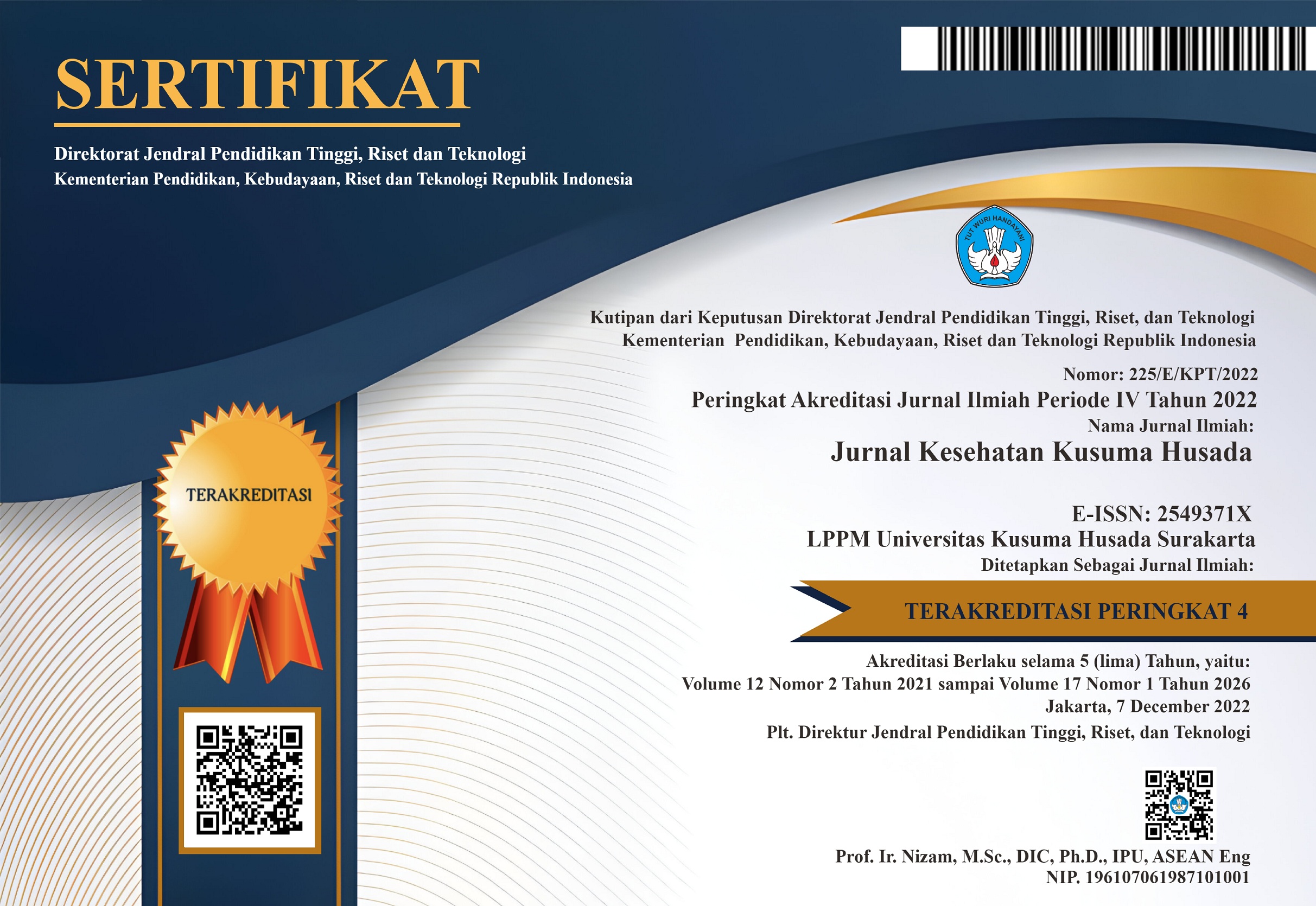PENGARUH PEMBERIAN MAKANAN RENDAH LEMAK TERHADAP MORFOLOGI SEL DAN EKSPRESI RESEPTOR-1 NEUROTENSIN (NTSR-1) PADA MUKOSA USUS TIKUS WISTAR JANTAN
DOI:
https://doi.org/10.34035/jk.v8i2.237Keywords:
neurotensin, , jejunoileum, imunohistokimia, neurotensin, jejunoileum, immunohistochemistryAbstract
Neurotensin merupakan protein yang memiliki fungsi ganda dan bekerja di otak dan usus sehingga sering disebut sebagai neuropeptida yang berperan sebagai neurtrasmitter saat di otak di otak dan disebut hormon saat berada di gastrointestinal dan bertujuan mengatur gerakan lambung,duodenum dan usus, serta sekresi asam lambung, penyerapan klorida dan air di usus besar, keberadaan neurotensin paling banyak terdapat di jejunoileum yaitu 85% dan neurotensin reseptor-1(NTSR-1) adalah reseptor terbanyak di jejunoileum. Makanan rendah lemak adalah makanan yang memiliki kadar lemak di bawah 25% dan memiliki pengaruh terhadap motilitas usus dan juga otak. Tujuan penelitian untuk mengetahui pengaruh pemberian makanan rendah lemak terhadap morfologi sel dan ekspresi reseptor-1 neurotensin (NTSR-1) di mukosa usus. Tikus wistar jantan berusia 3 bulan berjumlah 20 ekor di bagi kedalam 2 kelompok, Kelompok 1 diberikan makanan rendah lemak AIN 93 M kelompok 2 diberikan pakan tinggi lemak AIN-93G, perlakuan dilakukan selama 30 hari, kemudian dilakukan pemeriksaan Imunnohistokimia (IHC) dan pembacaannya menggunakan software IHC reader yang menghitung berdasarkan penyerapan warna pada slide,dan dilakukan pemeriksaan Hemotoxilin Eosin untuk mengetahui morfologi sel di usus Penelitian ini menunjukkan hasil rerata yaitu: kelompok 1 dengan pakan standar yaitu AIN 93M menunjukkan hasil rerata 51,08± 18,13 dengan rentang nilai 6,03-96,14. kelompok 2 dengan pakan AIN 93G didapatkan hasil 107,74± 18,67 dengan rentang nilai 61,34-154,13. Hasil pengamatan IHC pada pewarnaan HE menunjukkan tidak ada perubahan morfologi pada sel usus. Hasil penelitian menunjukkan bahwa dengan pemberian makanan tinggi lemak (AIN 93 G) dapat memicu sekresi neurotensin lebih tinggi. Makanan rendah lemak (AIN 93 M) tidak memicu sekresi neurotensin dan tidak merubah morfologi sel usus.
Neurotensin is a protein that has a dual function and work in the brain and the gut so often referred to as neuropeptides that act as neurtrasmitter current in the brain in the brain and is called hormone while in the gastrointestinal and respiratory stomach, duodenum and colon, as well as acid secretion Stomach, chloride and air absorption in the colon, found most neurotensin in jejunoileum ie 85% and neurotensin receptor-1 (NTSR-1) receptors in jejunoileum. Low-fat foods are foods that have a fat content below 25% and have an effect on the motility of the intestine and also the brain.This study aimed to determine the effect of food on the fat and cell morphology and expression of neurotensin receptor-1 (NTSR-1) in the intestinal mucosa. Rats Wistar male aged 3 months to 20 fish inside into two groups, Group 1 was given a low fat diet AIN 93 M group 2 is given high feed fat AIN-93g, this treatment is carried out for 30 days, then examined Imunnohistokimia (IHC) and the reading using IHC reader software that calculates based on the color absorption on the slide, and Hemotoxilin Eosin examination to determine the morphology of cells in the intestin. This study showed that the average results: group 1 with a standard feed that is AIN 93m shows the results mean 51.08 ± 18.13 with a range of values from 6.03 to 96.14. Group 2 with AIN 93G feed result of 107,74 ± 18,67 with value range 61,34-154,13. And the result of IHC observation on HE staining shows no morphological changes in intestinal cells. The results of this study showed that using a high-fat diet (AIN 93 G) could pass the secretion of higher neurotensin. Low-fat foods (AIN 93 M) do not escape neurotensin secretion and can not alter the morphology of intestinal cells.
Downloads
Published
Issue
Section
License
The copyright of the published articles belongs to Jurnal Kesehatan Kusuma Husada.

This work is licensed under a Creative Commons Attribution 4.0 International License.
















